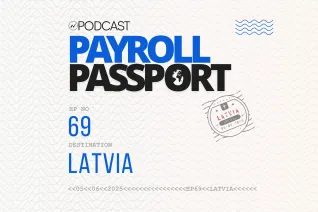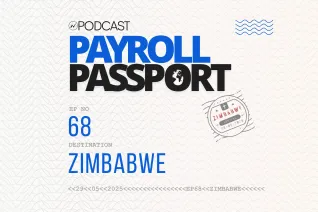Country Spotlight: Payroll in India

From the snow-capped Himalayas in the north to the tropical shores of the south, India is a land of contrasts—rich in culture, steeped in history, and driven by economic ambition. As the world’s most populous democracy and now the fifth-largest economy with a GDP of $4.27 trillion, India continues to solidify its position as a global growth powerhouse. With an estimated 6.5% growth for FY 2024–25 and a GDP per capita of $2,940, the country’s economic momentum remains strong and resilient.
Today, India is not just a preferred outsourcing destination - it’s a strategic launchpad for multinational enterprises looking to tap into a young, skilled workforce and a rapidly digitizing market.
Payroll Challenges in India & How to Overcome Them
Managing payroll in India presents a unique set of challenges due to the country’s multifaceted regulatory landscape. With labor laws governed at both central and state levels, and constant shifts in compliance thresholds, payroll teams must stay vigilant to avoid costly errors. Without a robust payroll framework, businesses risk compliance breaches, operational inefficiencies, and employee dissatisfaction.
Key Challenges & Solutions
1. Navigating Multi-State Compliance
India’s federal structure means each state can have its own rules around Professional Tax, Labour Welfare Fund (LWF), and public holidays. Companies operating across multiple states must accommodate these regional variations, often within the same payroll cycle.
Solution: Adopt a state-aware payroll system equipped with built-in rule engines that can automatically apply location-specific compliance rules. These systems reduce manual intervention and ensure accurate, state-compliant payroll processing.
2. Employee Classification & Statutory Obligations
Distinguishing between full-time employees, contractors, and gig workers is critical, as each category comes with its own set of tax implications and statutory requirements. Misclassification can lead to legal and financial liabilities.
Solution: Conduct regular employment audits and align workforce classifications with current labor laws. Partner with HR and legal teams to maintain compliance and documentation for each employee type.
3. Managing Employee Queries on Deductions & Allowances
Indian payroll often includes a wide range of deductions (e.g., EPF, ESI, TDS) and allowances (e.g., HRA, LTA), which can vary by individual and trigger frequent queries from employees.
Solution: Implement self-service payroll portals where employees can access detailed payslips, breakdowns of deductions, and frequently asked questions. This not only improves transparency but also reduces the administrative load on HR teams.
4. Coping with Constant Regulatory Shifts
Frequent changes in tax slabs, provident fund limits, and evolving labor codes (e.g., the new Labour Codes introduced by the Indian government) make payroll compliance a moving target.
Solution: Leverage a payroll provider or platform that offers real-time regulatory updates and automatic implementation of compliance changes. This helps businesses stay ahead of legal updates without the burden of manual tracking.
5. Hybrid Filing Requirements
Despite India’s digital transformation, several statutory filings—such as labour welfare submissions or state-level documentation—still require manual submissions or dual formats (digital and physical).
Solution: Maintain a dual compliance trail that includes both physical records and digital backups. Ensure your payroll system is capable of generating documents in formats suitable for both electronic and manual submission processes.
6. Managing Diverse Pay Cycles and Leave Structures
Organizations with multiple entities or business units often have varying pay frequencies and leave policies, which adds another layer of complexity to payroll operations.
Solution: Use configurable payroll engines with integrated leave and attendance modules. This allows customization by entity or region, ensuring consistency and control across diverse business units.
To effectively manage the growing complexities of payroll in India, organizations should adopt a sophisticated payroll platform that incorporates region-specific compliance logic, automates regulatory calculations, and supports scalable operations across multiple states. Leveraging the right technology enables companies to reduce administrative burdens, maintain compliance with evolving laws, and deliver consistent, error-free payroll as they expand their footprint.
ALSO READ I India: A Guideline to Payroll and Employer of Record
Payroll Tax Contributions
India’s payroll framework operates under a Pay-As-You-Earn (PAYE) model. Employees choose between the old and new tax regimes, and employers are responsible for deducting and depositing all applicable taxes and contributions. Employees have the flexibility to choose between the old tax regime, which allows for deductions and exemptions, and the new regime, which offers lower tax rates without exemptions. Employers must accurately capture and apply the chosen regime during payroll processing to avoid compliance issues.
1. Provident Fund (EPF)
EPF is a retirement-focused savings scheme. Both employer and employee typically contribute 12% of the employee’s basic salary. This includes allocations for a pension (EPS) and an insurance component, which is the Employees Deposit Linked Insurance Scheme (EDLI). Delays in depositing PF can lead to interest penalties and impact employee benefits.
2. Employees’ State Insurance (ESI)
ESI covers medical, maternity, and disability benefits for employees earning ₹21,000 or less per month. Contributions include 0.75% from the employee and 3.25% from the employer. Non-compliance may result in denied health coverage for eligible employees and legal consequences for the employer.
3. Professional Tax (PT)
Levied by states like Maharashtra and Karnataka, professional tax is deducted monthly based on income slabs. Employers must ensure accurate regional configuration to avoid penalties.
4. Labour Welfare Fund (LWF)
Applicable in certain states, LWF supports worker welfare initiatives like housing, education, and health services. Contributions are minimal but mandatory wherever applicable.
With multiple components, shifting thresholds, and state-specific rules, organizations benefit from automation and local expertise to stay compliant across jurisdictions.
Holidays and Leave Policies
India’s leave landscape is shaped by a mix of national mandates and regional customs.
Some of the National Paid Holidays include:
- Republic Day – 26 January
- Independence Day – 15 August
- Gandhi Jayanti – 2 October
Regional Holidays
Vary by state and religion, covering festivals such as Diwali, Eid, Holi, Onam, and Pongal. Most organizations offer 10 to 14 holidays annually, combining fixed and optional days.
Standard Leave Categories
- Casual Leave: 7–12 days; not carry-forwardable
- Sick Leave: 5–12 days; often carried forward
- Earned/Privilege Leave: 15–30 days; can be encashed or carried forward
- Maternity Leave: 26 weeks for the first two children
- Paternity, Bereavement, and Marriage Leave: Employer-defined
Given the variation, companies should implement a configurable leave management system to ensure state-wise compliance and transparency.
ALSO READ | Country Spotlight: Employer of Record in India
Seamless Employee Exit Management
Employee separation in India is governed by the Industrial Disputes Act, Shops and Establishments Acts, and standing orders.
1. Notice Period
Typically ranges from 15 to 90 days, depending on role and company policy. In some cases, early exits can be compensated with a salary-in-lieu arrangement.
2. Gratuity
Payable after five years of continuous service. The standard formula is (Basic + DA) ÷ 26 × 15 × completed years. It’s a key retirement benefit and a legal requirement.
3. Leave Encashment
Earned leave is often paid out during exit. This amount is taxable if encashed during service but may be partially exempt upon retirement.
4. Final Settlement
Must be cleared within 30–45 days for resignations and on the same day for terminations. This includes unpaid salary, bonuses, gratuity, encashments, and other dues.
Data Retention and Recordkeeping Requirements
Indian labor and payroll regulations emphasize the importance of maintaining accurate and accessible employment records. As per standard practices, organizations must retain employment records for a minimum of one year, unless a longer retention period is specified under the Digital Record Schedule (DRS).
Records to be retained include, but are not limited to:
- Job announcements and advertisements
- Employment applications and resumes
- Background investigation reports
- Letters of recommendation, even for applicants not hired
Employers are encouraged to digitize records wherever possible, using secure HR systems to ensure easy retrieval during audits or in case of legal disputes. Maintaining proper archival systems also supports smooth handling of terminations, payroll settlements, and compliance verifications.
Expat Payroll Considerations
India follows a residency-based tax system, which directly impacts how expats are taxed on payroll. The tax liability depends on the duration of stay and the source of income.
Residency Classification:
- Resident: Stayed in India for 182+ days in the financial year — Taxed on global income
- Not Ordinarily Resident (NOR): Limited exposure to global income — Taxed only on income earned in India and business controlled from India
- Non-Resident (NR): Stayed <182 days — Taxed only on Indian-sourced income
Handling expat payroll correctly ensures compliance with Indian tax law, minimizes dual taxation issues, and helps maintain a positive employee experience for international assignees.
Key Employer Considerations
- Accurately determine tax residency based on duration of stay and income thresholds
- Ensure expat employees are registered for a Permanent Account Number (PAN) for tax compliance
- Verify eligibility for social security exemptions under applicable bilateral agreements
- Facilitate compliant salary structuring and TDS deductions aligned with relevant tax slabs
As companies expand their presence across India, the intricacies of payroll administration become increasingly demanding. From managing state-specific regulations and tax frameworks to ensuring timely and accurate disbursements, each aspect requires detailed attention and localized insight.
In this complex environment, partnering with a payroll expert isn’t merely advantageous—it’s a critical component of scalable, compliant business operations.
Streamlining India’s Payroll
Businesses can navigate the complexities of payroll in India with Neeyamo’s global payroll solutions, designed to manage region-specific regulations, automate compliance, and support multi-state operations. From configuring diverse pay cycles and handling last-minute updates to ensuring precise tax deductions and timely filings, the platform simplifies payroll management at scale. With deep local expertise and robust technology, Neeyamo helps organizations stay compliant, minimize errors, and deliver seamless, stress-free payroll across India.
Why choose Neeyamo for your Global payroll needs?
Unlock the power of seamless global payroll management with Neeyamo's expert global payroll services. Neeyamo helps you navigate complex payroll regulations in 160+ countries, ensuring compliance and minimizing risks. Not convinced yet? Here's why we're your ideal partner:
Regulatory Roadblocks? Confidently navigate complex international laws & regulations.
Irritated with Integration? Seamlessly stitch together your HR systems.
Chaotic Control? Command your global workforce from a single platform.
Tardy Transactions? Ensure prompt and precise payroll processing.
Doubtful Digital Defense? Shield your sensitive information from digital threats.
Neeyamo? Your passport to hassle-free global payroll!
As you scale your workforce in India, ensure your payroll is not just compliant, but also future-ready.
Write to us at irene.jones@neeyamo.com to learn how Neeyamo Payroll™ can simplify your payroll operations.
Latest Resources
Stay informed with latest updates
If you're curious and have a thirst for knowledge pertaining to the HR, payroll, and EOR universe, don't miss out on subscribing to our resources.
















